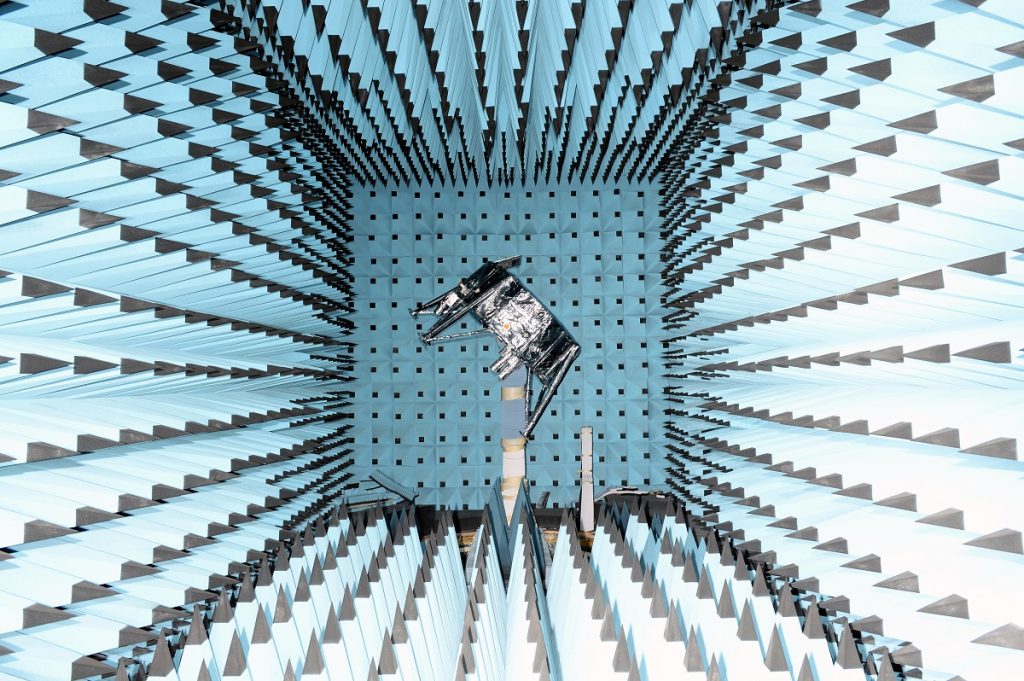Israel’s moon-bound spacecraft will carry a digital time capsule loaded with Hebrew songs, stories, Israel’s Declaration of Independence and national anthem, that will travel on the much-awaited mission to the moon and remain there indefinitely – as a special gift for future generations.
This is all part of Israel’s efforts to become the fourth country — after the US, Russia, and China — to complete a controlled lunar landing driven by Israeli startup SpaceIL.
The spacecraft, dubbed “Beresheet” (the Hebrew word for Genesis), will launch from Cape Canaveral, Florida, in February 2019 alongside other satellites as a secondary payload on a SpaceX Falcon 9 rocket.
SEE ALSO: Canadian Billionaire Contributes $5M To Israel’s Moon-Bound Startup SpaceIL
In a video on social media, SpaceIL, working alongside the Israel Aerospace Industries (IAI) presented the time capsule to IAI’s Space Division, which is making final preparations for the launch. The capsule consists of three discs, each containing hundreds of files that include details about the spacecraft and the crew; national symbols like Israel’s Declaration of Independence and its national anthem; a note from the late president Shimon Peres; the Bible; Israeli songs and literature; artwork and drawings made by children; the Wayfarer’s Prayer; information about Israeli scientific and technological discoveries and developments that influenced the world; photos of Israel’s landscapes and of leading figures in Israeli culture; and a children’s book inspired by SpaceIL’s mission to the moon.
The time capsule, along with the spacecraft, will remain on the moon indefinitely, even after completing Israel’s first lunar mission. With no plans to return to Earth, the spacecraft and information within the time capsule’s disks could be found by future generations, SpaceIL said in a statement.
“This is another step on our way to the moon,” said SpaceIL CEO Ido Anteby. “Inserting the disks into the spacecraft, which is a real ‘time capsule,’ indicates the spacecraft’s readiness to blast off from the launch site in a few weeks. SpaceIL’s crews and IAI have completed testing of the spacecraft and its systems, and are preparing for the beginning of the amazing and complex journey that exemplifies innovation, creativity, and courage. The spacecraft’s historic journey, which also includes a scientific mission, makes a significant contribution to advancing the space industry and the subject of space in Israel.”

SpaceIL’s Beresheet spacecraft. Photo by Yoav Weiss
SpaceIL was founded in 2010 by engineers Yariv Bash, Kfir Damari and Yonatan Weintraub, as part of a mission to take part in the Google Lunar X competition which came with a prize of $20 million. SpaceIL entered the race in 2012 and became the first international team in 2015 to sign a contract with aerospace manufacturer SpaceX and have its financial and technical details approved by the contest.
The original competition involved placing a spacecraft on the moon’s surface, traveling 500 meters on the moon, and transmitting high-definition video and images back to Earth. The winner would have won $20 million and the second-place team would have nabbed $5 million.
Sign up for our free weekly newsletter
SubscribeIsrael was one of five finalists in the final stage and was competing against four other teams: Moon Express (USA), Synergy Moon (an international collaboration of 15 countries), TeamIndus (India) and HAKUTO (Japan).
The March 2018 deadline came and went and the prize went unclaimed. But SpaceIL had vowed to maintain its efforts to put Israel on the moon, maintaining that its motivation was not the money, but about “showing the next generation that anything is possible – that even our small country can push the limits of imagination,” Anteby said in March.

A drawing made by a child of the SpaceIL project. Courtesy
“This is a very emotional moment,” said Winetraub, who inserted the time capsule into the spacecraft. “We do not know how long the spacecraft and the time capsule will remain on the moon. It is very possible that future generations will find this information and want to learn more about this historic moment.”
The precise launch date remains undetermined but once the spacecraft sets off, it will begin a complex journey that will take approximately two months.
SpaceIL explains that the spacecraft will disengage from the SpaceX launch rocket when it reaches 60,000 kilometers from the Earth’s surface and begin orbiting the Earth in elliptic orbits. It will circle Earth, widening its circumference each time, while saving fuel and only starting the engines at the end of each cycle. Then, at the right time, it will leave Earth’s gravity and enter the gravity of the moon. After circling the moon a few times, it will begin the landing process, carried out autonomously by the spacecraft’s navigation control system.
SEE ALSO: Fly Me To The Moon: SpaceIL Launches Funding Plea To Complete Space Race Amid Financial Troubles
The spacecraft, whose construction was carried out at IAI’s Space Division, successfully completed a series of tests to examine systems integration, and a series of complex experiments aimed at testing its durability.
In October, SpaceIL and the Israeli Space Agency announced a collaboration with NASA that will enable SpaceIL to improve its ability to track and communicate with the spacecraft before, during, and after landing on the moon.
SpaceIL is mainly a philanthropic project and has been funded by Sheldon Adelson, Sylvan Adams, the Schusterman Family Foundation, and the Morris Kahn Foundation, named after the South-African-Israeli billionaire who serves as SpaceIL’s president. The Israeli government has also provided funding.
Related posts

Editors’ & Readers’ Choice: 10 Favorite NoCamels Articles

Forward Facing: What Does The Future Hold For Israeli High-Tech?

Impact Innovation: Israeli Startups That Could Shape Our Future




Facebook comments